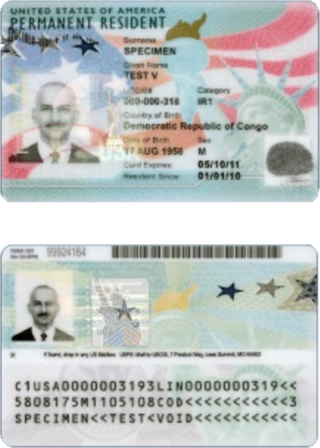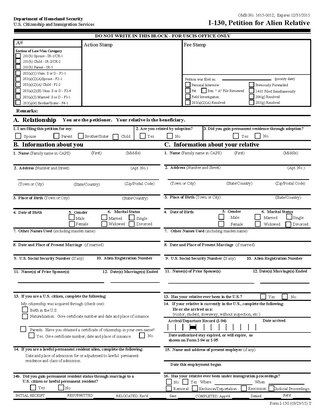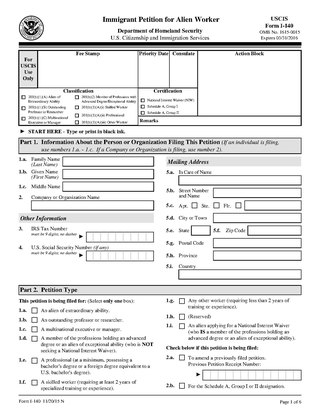Related Research Articles

A green card, known officially as a permanent resident card, is an identity document which shows that a person has permanent residency in the United States. Green card holders are formally known as lawful permanent residents (LPRs). As of 2019, there are an estimated 13.9 million green card holders, of whom 9.1 million are eligible to become United States citizens. Approximately 65,000 of them serve in the U.S. Armed Forces.
An L-1 visa is a visa document used to enter the United States for the purpose of work in L-1 status. It is a non-immigrant visa, and is valid for a relatively short amount of time, from three months to five years, based on a reciprocity schedule. With extensions, the maximum stay is seven years.
A K-1 visa is a visa issued to the fiancé or fiancée of a United States citizen to enter the United States. A K-1 visa requires a foreigner to marry his or her U.S. citizen petitioner within 90 days of entry, or depart the United States. Once the couple marries, the foreign citizen can adjust status to become a lawful permanent resident of the United States. Although a K-1 visa is legally classified as a non-immigrant visa, it usually leads to important immigration benefits and is therefore often processed by the Immigrant Visa section of United States embassies and consulates worldwide.
The USA PATRIOT Act was passed by the United States Congress in 2001 as a response to the September 11, 2001 attacks. It has ten titles, each containing numerous sections. Title IV: Protecting the Border aims to prevent terrorism in the USA through immigration regulations. The provisions of the title generally increase the difficulty of entering the country for those known to have, or suspected of having, terrorist intent.

The visa policy of the United States consists of the requirements for foreign nationals to travel to, enter, and remain in the United States. Visitors to the United States must obtain a visa from one of the U.S. diplomatic missions unless they come from one of the visa-exempt or Visa Waiver Program countries. The same rules apply for travel to all U.S. states, Washington, D.C., Puerto Rico and the U.S. Virgin Islands, as well as to Guam and the Northern Mariana Islands with additional waivers, while similar but separate rules apply to American Samoa.
Immigration and Naturalization Service v. Abudu, 485 U.S. 94 (1988), was a United States Supreme Court case in which the Court shifted the balance toward adjudications made by the INS and away from those made by the federal courts of appeals when aliens who had been ordered deported seek to present new evidence in order to avoid deportation. The Court ruled that courts must review the Board of Immigration Appeals's decision to deny motions to reopen immigration proceedings—the name of the procedural device used to present new evidence to immigration officials—for abuse of discretion.
Kleindienst v. Mandel, 408 U.S. 753 (1972), was a decision by the United States Supreme Court, which held that the United States Attorney General has the right to refuse somebody's entry to the United States, as he has been empowered to do so in § 212(a)(28) of the Immigration and Nationality Act of 1952.

Detroit Free Press v. Ashcroft was a case that was heard before the United States Court of Appeals for the Sixth Circuit in August 2002. The plaintiffs, Detroit Free Press, Detroit News, Michigan Representative John Conyers, and Rabih Haddad argued that it was a violation of the First Amendment for the defendants, Attorney General Ashcroft, Chief Immigration Judge Creppy, and Immigration Judge Elizabeth Hacker, to apply a blanket ruling of the Creppy Directive in order to keep immigration hearings closed to the press and the public. The case affirmed 3-0 that the blanket application of the Creppy Directive to all immigration hearings was unconstitutional.
There have long been ideological restrictions on naturalization in United States law. Nativism and anti-anarchism at the turn of the 20th century, the red scare in the 1920s, and further fears against communism in the 1950s each shaped United States nationality law. Though ideological exclusions on entry were largely eliminated in 1990, ideological bars arising from each of these time periods and prior still exist in American naturalization law. This long history has resulted in a naturalization statute that requires naturalization applicants to be "attached to the principles of the Constitution of the United States" and forbids them from adhering to several more specific ideological principles such as totalitarianism, communism, and anarchism.

Form I-130, Petition for Alien Relative is a form submitted to the United States Citizenship and Immigration Services by a United States citizen or Lawful Permanent Resident petitioning for an immediate or close relative intending to immigrate to the United States. It is one of numerous USCIS immigration forms. As with all USCIS petitions, the person who submits the petition is called the petitioner and the relative on whose behalf the petition is made is called the beneficiary. The USCIS officer who evaluates the petition is called the adjudicator.
Kerry v. Din, 576 U.S. 86 (2015), was a United States Supreme Court case in which the Court analyzed whether there is a constitutional right to live in the United States with one's spouse and whether procedural due process requires consular officials to give notice of reasons for denying a visa application. In Justice Anthony Kennedy's concurring opinion, the controlling opinion in this case, he wrote that notice requirements “[do] not apply when, as in this case, a visa application is denied due to terrorism or national security concerns.” Because the consular officials satisfied notice requirements, there was no need for the Court to address the constitutional question about the right to live with one's spouse.
Chae Chan Ping v. United States, 130 U.S. 581 (1889), better known as the Chinese Exclusion Case, was a case decided by the US Supreme Court on May 13, 1889, that challenged the Scott Act of 1888, an addendum to the Chinese Exclusion Act of 1882.
The National Visa Center (NVC) is a center that is part of the U.S. Department of State that plays the role of holding United States immigrant visa petitions approved by the United States Citizenship and Immigration Services until an immigrant visa number becomes available for the petition, at which point it arranges for the visa applicant(s) to take the visa interview at a consulate abroad. It is located in Portsmouth, New Hampshire. It was established on July 26, 1994, on the site of an Air Force base that was closed down by The Pentagon.
The Legal Immigration Family Equity Act of 2000, also known as the LIFE Act and as the Legal Immigration and Family Equity Act, along with its Amendments, made some changes to laws surrounding immigration for family members of United States citizens and Lawful Permanent Residents, as well as people eligible for employment-based immigrant visas, in the direction of making it easier for family members and immigrant workers to move to and adjust status within the United States. It was passed on December 21, 2000, as title XI of Pub. L. 106–553 (text)(PDF).
Withdrawal of application for admission is an option that U.S. Department of Homeland Security might offer to an Arriving Alien whereby the alien chooses to withdraw his or her application to enter the United States, and immediately departs the United States. Unlike an order of removal, a withdrawal of application for admission does not create a bar to future entry.
Fong Yue Ting v. United States, 149 U.S. 698 (1893), decided by the United States Supreme Court on May 15, 1893, was a case challenging provisions in Section 6 of the Geary Act of 1892 that extended and amended the Chinese Exclusion Act of 1882. The provisions in question required Chinese in the United States to obtain certificates of residency, and allowed for the arrest and deportation of Chinese who had failed to obtain these certificates, even if they had not violated any other laws. The case involved writs of habeas corpus from Fong Yue Ting and two other Chinese citizens residing in New York City who were arrested and detained for not having certificates. The Supreme Court decision was in favor of the United States government, upholding the Geary Act and denying the writs of habeas corpus.

Form I-140, Immigrant Petition for Alien Worker is a form submitted to the United States Citizenship and Immigration Service (USCIS) by a prospective employer to petition an alien to work in the US on a permanent basis. This is done in the case when the worker is deemed extraordinary in some sense or when qualified workers do not exist in the US. The employer who files is called the petitioner, and the alien employee is called the beneficiary; these two can coincide in the case of a self-petitioner. The form is 6 pages long with a separate 10-page instructions document as of 2016. It is one of the USCIS immigration forms.
Nishimura Ekiu v. United States, 142 U.S. 651 (1892), was a United States Supreme Court case challenging the constitutionality of some provisions of the Immigration Act of 1891. The case was decided against the litigant and in favor of the government, upholding the law. The case is one of two major cases that involved challenges to the Immigration Act of 1891 by Japanese immigrants, the other case being Yamataya v. Fisher.
Fiallo v. Bell, 430 U.S. 787 (1977), was a U.S. Supreme Court case that challenged the constitutionality of Sections 101(b)(1)(D) and 101(b)(2) of the Immigration and Nationality Act of 1952. The Sections gave immigration preference to children or parents of either existing U.S. citizens or of noncitizens residing under lawful permanent resident status. But, as the Court wrote, the statute defined “child” narrowly: “an unmarried person under 21 years of age who is a legitimate or legitimated child, a stepchild, an adopted child, or an illegitimate child seeking preference by virtue of his relationship with his mother”.
Shaughnessy v. United States ex rel Mezei, 345 U.S. 206 (1953), was a United States Supreme Court case that established the federal government's power to detain migrants at the border pending deportation. The Supreme Court, in a five to four decision, held that the Attorney General's continued exclusion of the unauthorized immigrant without a hearing does not amount to an unlawful detention, and the court may not temporarily admit such individuals into the United States pending arrangements for their departure abroad. Some consider the decision in Shaughnessy v. United States ex rel Mezei as the Court's strongest statement of the plenary power doctrine as the power to permanently exclude noncitizens is based in U.S. sovereignty and largely immune from judicial control.
References
- 1 2 Johnson, Kevin (February 18, 2015). "Argument preview: The doctrine of consular non-reviewability – historical relic or good law?". SCOTUSblog. Retrieved September 29, 2015.
- 1 2 3 4 5 6 7 8 Dobkin, Donald. "Challenging the Doctrine of Consular Non-Reviewability in Immigration Cases" (PDF). Archived from the original (PDF) on December 18, 2015. Retrieved January 8, 2016.
- 1 2 Chodorow, Gary. "Options after a Consular Officer Denies Your U.S. Visa Application". U.S. & China Visa Law Blog. Retrieved October 22, 2015.
- 1 2 3 4 5 6 7 8 "Brief of Amicus Curiae Law Professors in Support of Respondent (Kerry v. Din)" (PDF). American Bar Association.
- ↑ "Knauff v. Shaughnessy, 338 U.S. 537 (1950)". Justia . Retrieved September 29, 2015.
- ↑ Chodorow, Gary. "Kerry v. Din: Supreme Court Rules Embassy Need Not Tell U.S. Citizen Why Husband's Visa Denied". Law and Border. Retrieved January 16, 2016.
- ↑ Choi, Jungmin (November 18, 2015). "Doctrine of Consulate Nonreviewability After Kerry v. Din". Epstein Becker Green. Retrieved January 16, 2016.
- ↑ Kagan, Michael. "Plenary Power is Dead! Long Live Plenary Power!". Michigan Law Review . Retrieved January 16, 2016.